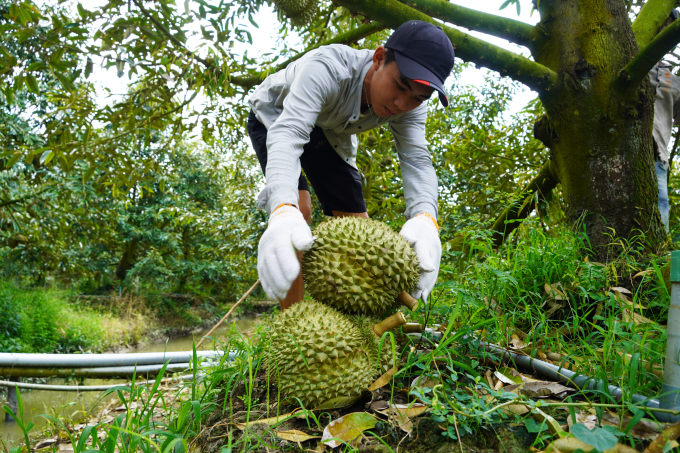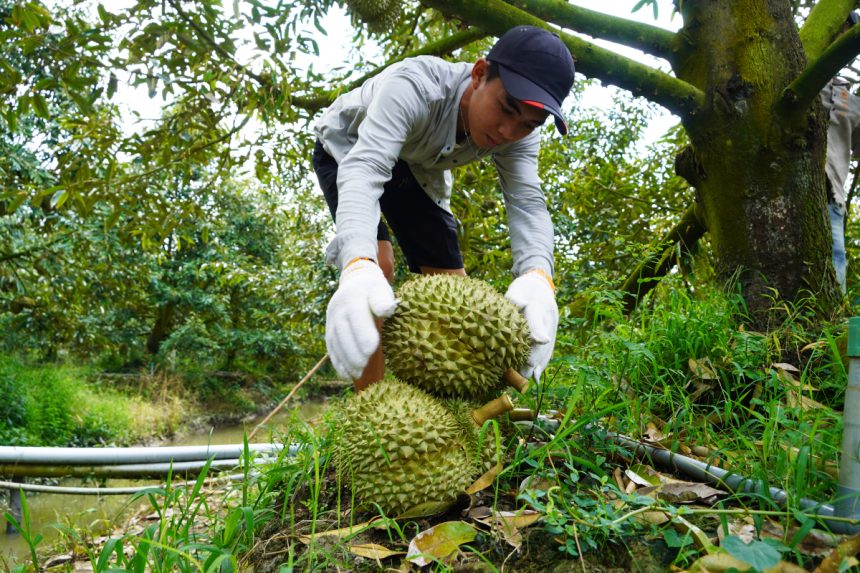Durian, rambutan, and many rice varieties will soon disappear from the Mekong Delta because saline drought is moving deeper and deeper inland, according to Dr. Dao Phu Quoc.
“Salinity is getting deeper and deeper, durian and rambutan are less salt-tolerant among fruit trees grown in the West,” said Dr. Dao Phu Quoc, Director of the Center for Sustainable Development and Biodiversity (University of Ho Chi Minh City National University) stated at the international conference on Sustainable Development of the Mekong Subregion organized by Ho Chi Minh City University of Law, June 7.
The West is Vietnam’s largest fruit basket, of which more than 20,000 hectares of durian are distributed mainly in Tien Giang, 8,061 hectares of rambutan, and nearly 23,500 hectares of grapefruit. Recently, farmers have massively abandoned thousands of hectares of rice and jackfruit to grow durian, so the area of this crop has increased rapidly.
According to Dr. Dao Phu Quoc, among the fruits grown in the West, durian is the least salt-tolerant, followed by rambutan, orange, tangerine, and grapefruit. Specifically, durian’s salt tolerance threshold is about 0.64 parts per thousand, meaning each liter of water has 0.64 grams of salt; The salt tolerance threshold of rambutan is 1.28 parts per thousand. Meanwhile, water in estuaries is up to 4 parts per thousand saline, meaning each liter of water has up to 4 grams of salt.

Dr. Dao Phu Quoc spoke at the conference, June 7. Image: Le Tuyet
This expert believes that through monitoring over the years, the level of salinity intrusion is getting deeper and the level of salinity is getting bigger and bigger. In the Vam Co Dong and Vam Co Tay rivers, from the river mouth, salinity reaches a depth of up to 150 km, recorded in 2020.
“Salinity is getting heavier and deeper and deeper, then durian, rambutan, citrus and many rice varieties will gradually disappear,” Mr. Quoc said, saying that in fact during the past time, when salinity drought occurred, durian and rambutan Rambutan leaves have withered leaves, reducing productivity. Therefore, the state and localities need to have timely response solutions and change crops to ensure people’s livelihoods.
According to experts, saltwater intrusion is inevitable, so “it is necessary to turn challenges into opportunities”. There are many types of economically valuable aquatic products suitable for brackish and salty water environments rich in minerals such as white-legged shrimp, tilapia, and some mollusks with export value. With fruit trees, for example, custard apple has good salt tolerance, which is popular in the US market but Vietnam does not pay attention. There are many new rice varieties that can withstand level 5 salinity, equivalent to 12.5 parts per thousand.
At the conference, Ms. Luu Thi Thanh Mau, General Director of Phuc Khang Company, said that the unit has a pilot model to transform livelihoods for people in Hau Giang. Through research, businesses found that the West has 6 difficulties facing change including: being influenced by the market, lack of direction; Climate Change; labor shortage, limited capacity; high costs, lack of capital for production when converting; Some local policies are not really effective; Impact from other countries’ activities in exploiting and using Mekong River water resources.
From the pilot model and the difficulties of the people, Ms. Mau believes that for sustainable development, it is necessary to convert farming and animal husbandry from individual, small-scale households to large-scale farms combining technology. High technology, aiming at the goal of clean agriculture. Agricultural land is both cultivated and raised, but is researched and combined with ecotourism.

Harvesting durian in Cai Lay town, Tien Giang. Image: Hoang Nam
Meanwhile, Dr. Dao Phu Quoc said that in addition to converting crops and livestock, the government needs to consider technical and financial solutions and incentives for businesses participating in agricultural and aquatic product processing. For example, in terms of technology, adaptation solutions must be synchronous, including building dams, narrowing the flow in the estuary to store fresh water and limit seawater overflowing with the tides.
In addition, the state needs to have a policy to allow people to borrow capital to create new livelihoods, along with support packages for transferring farming techniques or providing them with technical training before granting loans. Enterprises involved in processing agricultural, aquatic and aquatic products need investment incentives such as capital and technology.
According to research by the Institute of Water Resources Science, Ministry of Natural Resources and Environment, from the salinity intrusion map, four industries of rice, fisheries, fruit trees, and crops of the Mekong Delta in the period 2020-2023, losses of more than 70,000 billion VND each year.
In the past 10 years, the West has experienced two major droughts and saltwater intrusions. The historic drought in 2016 caused 160,000 hectares of land to become salty, causing damage of more than 5,500 billion VND. 10 out of 13 provinces and cities in the area had to declare natural disasters. Four years later, saltwater drought lasted more than 6 months, causing 6 western provinces to declare an emergency saltwater drought situation. More than 43,000 hectares of rice were damaged, 80,000 households lacked water. The government spent 530 billion VND for 8 provinces here to respond.
Le Tuyet



